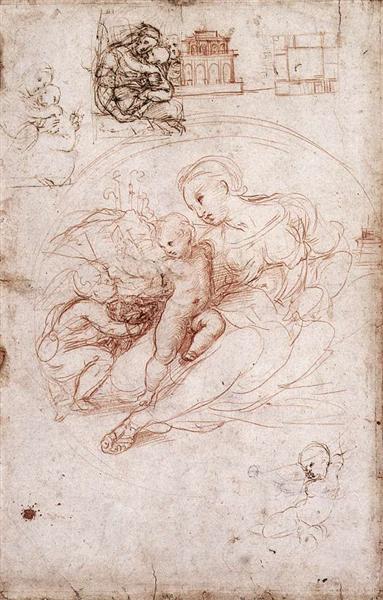Popis
The 1513 painting "Studies of the Virgin" by the Renaissance master Raphael Sanzio stands as an involutionary and profound testimony to the artist's mastery in the genre of religious portraiture. Characterized by its function as a preparatory work, this drawing stands out not only for its extraordinary technique, but also for Raphael's ability to capture the essence of the maternal figure in a deeply spiritual context.
In the painting, the figure of the Virgin Mary is the focal point, presented with a serene expression that exudes both grace and strength. The position of her slightly tilted head, combined with her soft gaze and the gesture of her hand, suggests a moment of deep reflection or emotional connection. Her face, delicately sketched and rendered in a palette of soft tones, denotes a subtlety characteristic of Raphael, who displays an impressive mastery in the representation of human anatomy and proportions.
The use of colour in this study is remarkably effective. The palette, which ranges from soft blues to warm reds and terracottas, creates a contrast that highlights the luminosity of the figure of the Virgin. Furthermore, the interplay of light and shadow brings a subtle dynamism to the composition, suggesting an enveloping atmosphere that complements the search for spirituality that the artist is trying to convey. This focus on light is an aspect that can also be seen in other works of his time, such as "The Virgin of El Rocío".
What makes “Studies of the Virgin” particularly intriguing is its function as a study. Raphael is not merely depicting the Virgin; he is exploring her characteristics and virtues through the sketch. This relationship between a preparatory study and the final work highlights the importance of Raphael’s work in developing his visual language, where each stroke becomes a step towards a greater understanding of the sacred figure.
As for the characters, there are no additional figures or complex narrative elements in this study. The depiction of the Virgin stands on its own, allowing the viewer to focus on her figure and the symbolic charge she carries with her. This reduction to a single figure is characteristic of Raphael's mastery, who uses simplicity to elevate the spiritual content.
In the broader context of the Renaissance, Raphael is recognizable for his ability to combine idealized beauty with a human interpretation of divinity. Studies of the Virgin is emblematic of this ability, evoking palpable emotion and a sense of reverence before the maternal figure. This drawing should not be seen merely as a precursor to future works but as a profound and contemplative exploration of motherhood and the sacred, showing how Raphael can, with just a few strokes, encapsulate a profound and universal message.
In conclusion, “Studies of the Virgin” is a work that continues to resonate not only in our understanding of Renaissance art, but also in the appreciation of the female figure in religious art. Raphael, through his genius, offers us a window into his creative process, where every line and every color has the ability to speak to the human experience and the search for the divine. The painting is a brilliant example of how studies can illuminate the understanding of the more complex works that follow these preparations, highlighting the artist’s mastery and unique vision of the world.
KUADROS ©, a famous painting on your wall.
Hand-made oil painting reproductions, with the quality of professional artists and the distinctive seal of KUADROS ©.
Painting reproduction service with satisfaction guarantee. If you are not completely satisfied with the replica of your painting, we will refund 100% of your money.

